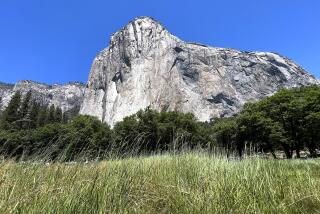Report Calls for More Scientific Study of National Parks : Environment: To avert deterioration, it also urges appointment of a chief scientist and the creation of a budget to be used only for research.
- Share via
WASHINGTON — The nation’s crowded, environmentally besieged national parks must be subjected to increased scientific study and research to avert deterioration, according to a study released Wednesday by the prestigious National Research Council.
Currently, the report warned, officials short of crucial scientific insight are called upon to make far-reaching choices between preserving natural treasures and providing service to mounting numbers of campers and sightseers.
The study, sent to the Interior Department and its National Park Service, urged that Congress mandate a research mission for the Park Service. The council also called for appointment of a chief scientist for the parks and the creation of a budget to be used only for scientific research.
“We think these issues are so visible and so important that the Park Service is going to respond,” said Paul G. Risser, vice president of the University of New Mexico at Albuquerque, who headed the two-year assessment.
Nearly identical recommendations have been made in the past but have produced no profound action. Critics maintain that scientific judgment has been colored by politics and that much of what the Park Service has considered research has been nothing more than resource management.
Within an hour of release of the report, Administration officials endorsed its general thrust.
Michael Hayden, assistant secretary of the Interior for fish, wildlife and parks, called the findings “an excellent blueprint for actions needed to take certain functions of the Park Service into the 21st Century.”
Similarly, Park Service Director James Ridenour, who requested the study, said he regards a “science capability” as the first priority for his agency in its obligation to provide a national demonstration of environmental protection.
But the officials stopped short of promising to carry out the report’s specific recommendations.
For instance, the apparent mechanism to create a parks research mission would be to incorporate it into the 1916 act that established the National Park Service. But efforts to do so, Ridenour said, could present “an opportunity for mischief,” changing the clear, simply stated mission of the system, which encompasses 360 different sites--ranging from the White House and its grounds to sprawling parks such as Yellowstone and Yosemite.
Ridenour also skirted Risser’s suggestion that 300 or more scientists be added to the Park Service staff.
The service has about 112 scientists, which Hayden termed “woefully inadequate.” That amounts to about 3% of its staff, and Risser noted that other federal agencies devote as much as 10% of their manpower to research activities.
But Ridenour, alluding to tight federal budgets, suggested that scientific manpower could be beefed up by enlisting university researchers and by borrowing scientists from federal agencies such as the U.S. Fish & Wildlife Service and the U.S. Geological Survey.
Nevertheless, he said, “I don’t think there is any doubt that we will push to hire more scientists.”
In the course of its investigation, Risser said, the 12-member panel explored numerous cases where scientific research has paid off for the park system, as well as unfortunate episodes created by inadequate information about the effects of decisions.
A notable success story, he said, is the case of the giant sequoias in Sequoia National Park, which were endangered because the Park Service assumed that they benefited from uncompromising fire control. Research eventually showed that fires, in fact, help produce seed beds and promote propagation of the species. The Park Service now conducts a controlled burning program within the park.
Less pleasant examples abound: The disastrous 1988 fires in Yellowstone, aggravated by a lack of understanding of conditions that existed at the time of the outbreak; and the deterioration of the Everglades, which Ridenour called the country’s most endangered national park.
Park Service officials have identified some $200 million to $300 million worth of research projects that need to be done. In that regard, the National Resource Council revealed little that was not already “on the shelf,” the National Parks and Conservation Assn. said.
More to Read
Sign up for Essential California
The most important California stories and recommendations in your inbox every morning.
You may occasionally receive promotional content from the Los Angeles Times.













